Regardless of what your fantasy baseball league's format might be, when it comes time to draft your team -- and specifically, your pitching staff -- if you end up with any of the top-tier options (Gerrit Cole, Jacob deGrom, Justin Verlander, Max Scherzer) you're going to be very happy. After all, unless you're playing in a league with some sort of bizarro way-out-there scoring system -- "50 bonus points for each balk and wild pitch; Matthew Boyd, first-rounder" -- these elite arms are going to be the first hurlers off the board.
Having said that, there are certain pitchers whom one might expect to have better results in a points league as compared to category-based scoring systems. In fact, comparing my points league rankings to that of my colleagues Tristan H. Cockcroft (H2H Categories) and Eric Karabell (Roto), there are several names that jump out at me as being way more recommended on my list than theirs.
So, let's take a look at a few of these outliers and see whether we can figure out what makes them unexpected pitchers to target in a points-league format.
 Zack Greinke, Houston Astros
Zack Greinke, Houston Astros
My SP rank (7), Tristan's SP rank (16), Eric's SP rank (14)
If you're playing in a league where strikeouts are a category you have to contend with, then I get why Greinke might not be in this season's top-10 SP rankings headed into the season. He's 36, and in the midst of a steady decline of his K/9 rate (9.56 in 2017, 8.62 in 2018, 8.07 in 2019). However, in points leagues, it's not so much the K's as it is the ratio of those whiffs to walks. Strikeouts earn you a point and walks take them right back, so it's worth noting that Greinke was sixth (among qualified starters) last season in K/BB at 6.23.
 Mike Soroka, Atlanta Braves
Mike Soroka, Atlanta Braves
My SP rank (12), Tristan's SP rank (28), Eric's SP rank (26)
Continuing this conversation, normally my cutoff for considering a pitcher for my staff is a K/BB rate of around 3.50. Last season, while his strikeout count was only 142, Soroka came very close to my threshold in this stat, ending up with a 3.46 K/BB. However, combine that with his 51.2% ground-ball rate and we're looking at a pitcher who should consistently end up with a lower ERA than his xFIP might indicate, just as he did in 2019 (2.68 ERA, 3.85 xFIP). Color me optimistic.
 Madison Bumgarner, Arizona Diamondbacks
Madison Bumgarner, Arizona Diamondbacks
My SP rank (19), Tristan's SP rank (35), Eric's SP rank (25)
How the mighty have fallen! At this point of Mad Bum's career, anyone drafting him will likely be thrilled if he even reaches double-digit wins in 2020 (which would be the first time since his 15-win 2016). However, while wins do get you some points, what gets you more points is working deeper into games, since you are typically awarded a point for each batter your pitchers retire. Longevity is especially valued in leagues that give out bonuses for quality starts (QS). Last season, on average, Bumgarner worked into the seventh inning of his starts and finished with 20 QS.
 Mike Minor, Texas Rangers
Mike Minor, Texas Rangers
My SP rank (23), Tristan's SP rank (49), Eric's SP rank (34)
Minor is a perfect example of someone who seemingly succeeds in points leagues by brute force alone. Last year, he finished about 35 slots better on the top points-league pitching performers list than he did on the ESPN Player Rater. He also threw, on average, 6.5 innings per start, and that was with a less-than-elite 3.59 ERA. There's a decent chance that number might drop a bit, as his 2019 home stats were considerably worse (4.31 ERA, .266 BAA in Arlington) compared to elsewhere (2.99, .224). While we won't know until the games start what the impact of the new stadium will be for the Rangers staff, it's certainly possible that new conditions could benefit Minor and his rotation-mates.
 Joe Musgrove, Pittsburgh Pirates
Joe Musgrove, Pittsburgh Pirates
My SP rank (26), Tristan's SP rank (58), Eric's SP rank (72)
One reason for optimism with Musgrove is the fact he had a 63.2% LOB rate (also called strand rate) last season, which was the absolute worst in baseball among qualified SP. Generally speaking, pitchers tend to regress to around 70-72% in this category, which puts Musgrove in line for fewer runners to cross the plate in 2020, even if his other peripherals stay exactly the same. In other words, just by taking away the negative impact of a handful of earned runs, we should expect to see Musgrove leap about 15-20 spots in the SP ranks.
 Marcus Stroman, New York Mets
Marcus Stroman, New York Mets
My SP rank (40), Tristan's SP rank (63), Eric's SP rank (88)
I foresee a much better K/BB from Stroman in 2020, not only due to an improved changeup but also to my own personal observation that pitchers who get in-game advice from catcher Rene Rivera (whether he's on the field or not) tend to shine. In fact, Stroman's performance after being traded to the Mets last season came along with an immediate uptick in the strikeout department (9.1 K/9 vs. 7.1 in Toronto). We have here another "innings eater" type who should be good for 200 IP, and thus a very high floor for points-league value.
 Marco Gonzales, Seattle Mariners
Marco Gonzales, Seattle Mariners
My SP rank (45), Tristan's SP rank (94), Eric's SP rank (82)
Let's first factor in the unluckiness, as Gonzales' 69.2 LOB% left him as one of only seven qualified SP under the 70% mark in 2019. Next, let's remember that you also lose points for hits allowed in most scoring systems. Gonzalez finished 2019 strong with a .192 BAA in his last four starts, and if you take away his three starts against the two Texas teams, his ERA was 2.41 over the last two months of the season. He's definitely pointing in the right direction.
 Mike Leake, Arizona Diamondbacks
Mike Leake, Arizona Diamondbacks
My SP rank (47), Tristan's SP rank (NR), Eric's SP rank (NR)
A lot of the reason for Leake not being ranked in either Tristan or Eric's top-125 SP is the fact he has a fracture in his left (non-throwing) wrist and has yet to pitch in a game this spring. However, he's still expected to take the mound for Arizona's fifth game of the season in about three weeks. That's a good sign. Assuming he, at worst, misses one or two turns in the Arizona rotation, he's a perfect fit for a No. 5 fantasy starter -- if you choose to go that deep (see below). He had a 4.70 K/BB (12th among qualifiers) and I'm willing to chalk up last year's MLB-high 41 HR allowed to a combination of the baseballs in use and a fluky home-road split (12.5% HR/FB at home, 24.8% away).
What about the bullpen?
Before we close our discussion on pitching, we need to talk about relievers. Saves are worth five points in ESPN standard scoring but because we're not dealing with the task of competing in specific statistical categories, you don't actually need them, per se. In fact, you don't need to draft any closers at all if you don't want to. However, some fantasy managers (myself included) like to go with a pitching staff consisting of one ace and as many closers as possible.
This tactic can pay huge dividends because, while the best starting pitchers do typically end the season with the most overall points, when broken down on a week-to-week basis, there's a huge amount of variance. One disastrous start can single-handedly turn a potential win into a loss. Closers, however, tend to get into games only when there's a chance to earn a save. On top of that, there's not as much chance for disaster as they don't get docked harshly for any inherited runners they allow to score; those runs are charged to the guy who put them on base. Get two to three save opportunities each from seven to eight closers each week and the potential for points is far greater than if you used five to seven so-so streaming SPs instead.
Now, when it comes to ranking relievers in the preseason, you shouldn't pay much attention to the names of the pitchers themselves. Rather, it's their teams that matter. Closers keep their jobs only for as long as their managers have confidence in them. Many bullpens are overcrowded with options and an "official announcement" regarding who will win those coveted ninth-inning jobs might not come until just prior to Opening Day. In other words, while we're currently high on the likes of Nick Anderson (Rays) and Giovanny Gallegos (Cardinals), if those jobs suddenly go to Diego Castillo or Andrew Miller instead, then you're probably going to see those pairs of teammates just swap places in the rankings.
However, this doesn't mean there isn't also some inherent value to those eighth-inning guys (especially in the new "must face three hitters" environment) who are unlikely to be moved from those roles, even if something happens to their teams' closers. You're looking at potentially just as many (if not more) appearances per week, which is ideal for streaming them into your fantasy lineups if you can make daily moves, and particularly so on the days after the closer has pitched back-to-back outings. Standouts in this group who have an expected K/9 rate of 10.0 or more and a K/BB rate of at least 4.50 include Ryan Pressly (Astros), Chris Martin (Braves), Seth Lugo (Mets) and Tommy Kahnle (Yankees).
